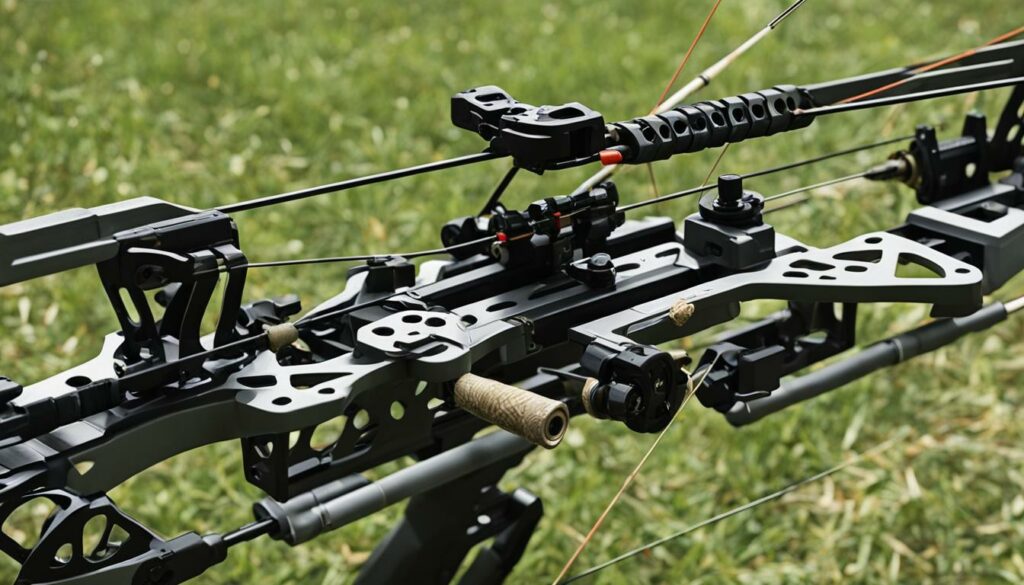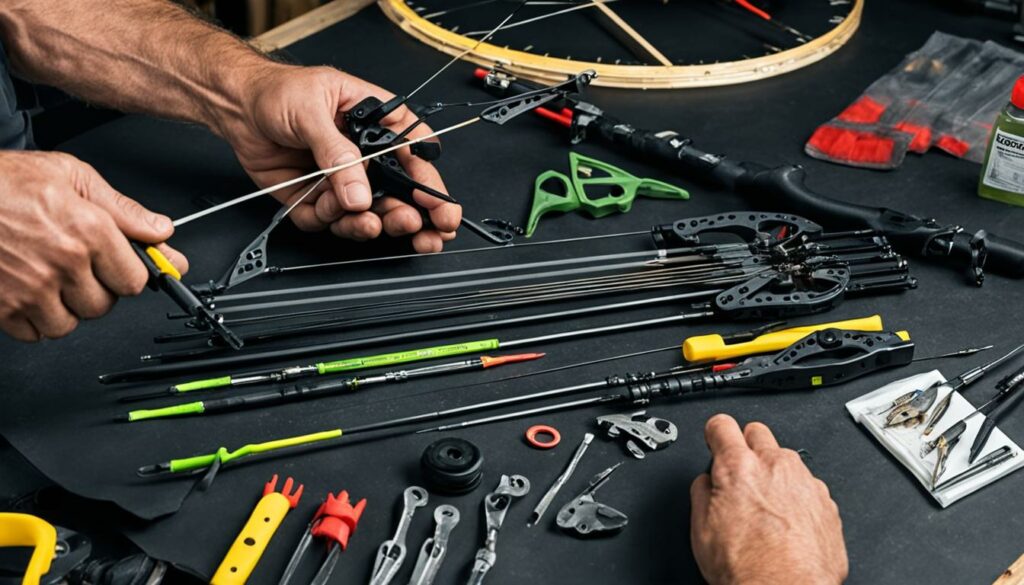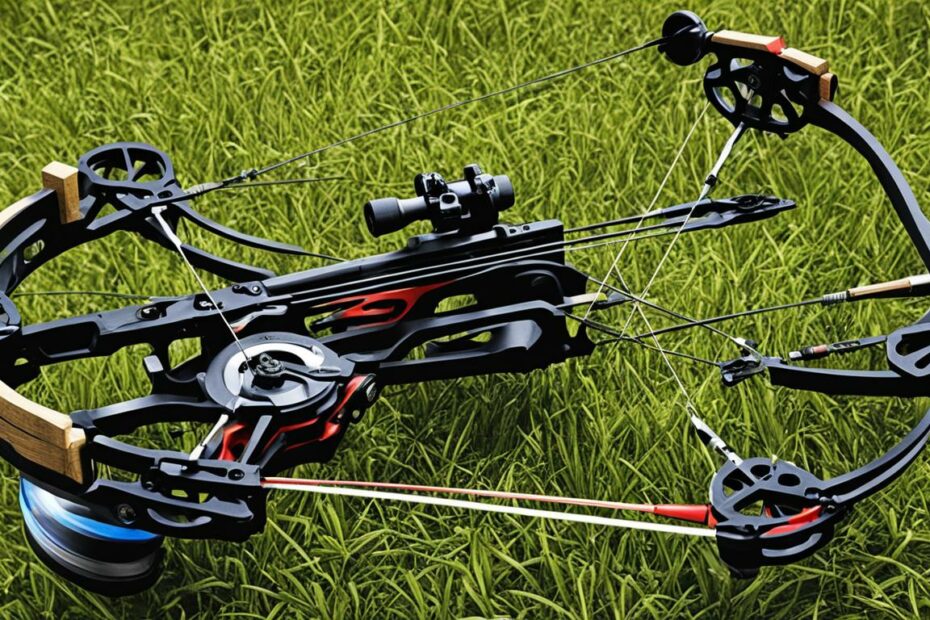Compound bows operate on storing and transferring energy to propel arrows with speed and accuracy. The key to their efficiency lies in the cam pulley system, which minimizes energy losses and optimizes energy transfer.
As the archer draws the bowstring back, the limbs flex, storing potential energy. The rotatable cams reduce the draw weight the archer feels, a feature known as a let-off. This allows for a steadier aim and increased accuracy.
The Energy Transfer Process
When an archer draws a compound bow, the limbs flex and store energy. The amount of energy stored depends on the draw weight and length. The cams in a compound bow rotate as the string is drawn back, reducing the force required to hold the bow at full draw.
This “let-off” allows the archer to maintain a steady position and take longer to aim. When the string is released, the energy stored in the flexed limbs is transferred to the arrow, propelling it forward at high speeds. Compound bows can achieve arrow speeds of up to 370 feet per second, making them highly powerful and accurate.
The Role of Cam Design
The design of the cams in a compound bow plays a crucial role in its performance. The shape and configuration of the cams directly affect the bow’s draw weight, draw length, and let-off. Different cam designs can provide different draw-force curves and let-off percentages.
Some cam designs are more aggressive, with a higher peak draw weight and less let-off, resulting in a faster arrow speed. Other cam designs prioritize comfort and ease of use, with a lower peak draw weight and higher let-off. The choice of cam design depends on the archer’s preferences and shooting style.
To understand the impact of cam design on a compound bow’s performance, let’s compare two popular designs – the aggressive cam and the comfort cam. The aggressive cam is known for its high peak draw weight and lower let-off, making it ideal for archers who prioritize maximum arrow speed and power.
On the other hand, the comfort cam offers a lower peak draw weight and higher let-off, providing a more comfortable shooting experience for archers who value ease of use and accuracy over sheer speed.
Here’s a comparison table highlighting the main differences between the aggressive cam and comfort cam:
| Aggressive Cam | Comfort Cam | |
|---|---|---|
| Peak Draw Weight | Higher | Lower |
| Let-off | Less | Higher |
| Arrow Speed | Faster | Slower |
| Comfort | Lower | Higher |
The aggressive cam design delivers greater arrow speed due to its higher draw weight and lower let-off. This suits archers who participate in competitions or require more penetrating power.
On the other hand, the comfort cam design prioritizes ease of use and comfort, making it a popular choice for beginners, recreational shooters, or those who prioritize accuracy over speed.
Both cam designs have unique advantages, and choosing the right one depends on an archer’s preferences and shooting goals.
Understanding the Draw Cycle
The draw cycle of a compound bow plays a crucial role in an archer’s shooting experience. It refers to the force required to draw the bowstring back and the changes in force throughout the draw. The compound bow’s draw weight and cam design are two key factors influencing the draw cycle.
Compound Bow Draw Weight
A compound bow’s draw weight is the force required to draw the bowstring fully. It determines the initial resistance an archer needs to overcome when pulling the string back. The draw weight is typically measured in pounds (lbs) and can vary depending on an archer’s strength and skill level.
Compound bows enable adjustability in draw weight to accommodate different archers and shooting preferences. This adjustability is achieved through different limb configurations and settings on the bow.
Compound Bow Cam Design
The cam design of a compound bow significantly affects the draw weight curve and overall shooting performance. Various cam designs are available in the market, each with unique characteristics and benefits.
Some compound bow cam designs reach peak weight quickly and hold it longer during the draw cycle. These designs are often favored by archers who prioritize a faster arrow speed and a more aggressive shooting style.
On the other hand, other cam designs offer a smoother and friendlier draw force curve. These designs provide a more gradual increase in draw weight, allowing for an easier and more comfortable draw. This can benefit archers who prefer a slower, controlled draw cycle.
The choice of cam design depends on an archer’s shooting style, preference for speed, and ease of use. Different cam designs offer unique trade-offs between draw weight, draw length, and let-off, allowing archers to find a configuration that suits their needs.
| Cam Design | Benefits |
|---|---|
| Aggressive Cam | Faster arrow speed Higher peak draw weight |
| Smooth Cam | Easier and more comfortable draw Smaller peak draw weight |
The Role of Limbs and Risers
The limbs and riser are vital components that contribute to the construction and performance of a compound bow. Understanding their role is crucial for anyone seeking to comprehend compound bow construction and the significance of different parts.
The limbs, typically made of fiberglass-based composite materials, play a pivotal role in storing and releasing the bow’s kinetic energy. These limbs are designed to withstand high tensile and compressive forces, ensuring optimal performance and durability.
On the other hand, the riser, also known as the handle, serves as the central mount for various components, including the limbs, sights, stabilizers, and quivers. It is typically constructed using aluminum, magnesium alloy, or carbon fiber for maximum rigidity and durability. The rigid riser contributes to the overall accuracy and performance of the compound bow.
The strong limbs and rigid riser create a sturdy foundation for the compound bow, enabling efficient energy transfer and precise arrow release. This combination of components ensures a reliable and accurate shooting experience for archers of all levels.

The Role of Limbs:
- Made of fiberglass-based composite materials
- Store and release the kinetic energy of the bow
- Designed to withstand high tensile and compressive forces
The Role of Riser:
- Serves as the central mount for various components
- Includes limbs, sights, stabilizers, and quivers
- Constructed using aluminum, magnesium alloy, or carbon fiber
- Provides maximum rigidity and durability
Advantages of Compound Bows
Compound bows offer several advantages over traditional bows. A compound bow’s pulley/cam system provides a mechanical advantage, allowing for higher draw weight and faster arrow speeds than recurve bows or longbows.
The let-off provided by the cams reduces the holding weight at full draw, making it easier for the archer to maintain a steady aim.
The rigidity of the limbs and the design of the cams contribute to the overall energy efficiency and accuracy of compound bows. The ability to adjust draw length and let-off make compound bows more versatile and user-friendly.
Compound bows’ superior draw weight and arrow speed performance are critical advantages. The pulley/cam system allows for a higher draw weight, translating into more power behind each shot.
This increased draw weight enables compound bows to shoot arrows at higher velocities, resulting in flatter trajectories and greater accuracy at longer distances.
Compared to traditional bows, compound bows can achieve arrow speeds of up to 370 feet per second, making them ideal for hunting or target shooting.
Additionally, the let-off provided by the cams is another significant advantage of compound bows. The let-off refers to the reduction in holding weight when the bow is at full draw. As the archer reaches full draw, the cams rotate and take over most of the weight, allowing the archer to steady the bow with less effort.
This reduced holding weight not only increases accuracy but also enables the archer to aim and hold the bow for longer periods without fatigue. It is especially beneficial when precision and stability are crucial, as in competitive archery.
The rigidity of the limbs and the design of the cams also contribute to the compound bow’s overall performance. The limbs of compound bows are made of composite materials that provide exceptional strength and durability.
This rigidity ensures minimal energy loss and efficient energy transfer to the arrow upon release, improving arrow speed and accuracy. The design of the cams further enhances the bow’s performance by optimizing the draw force curve and let-off percentage, providing a smooth and consistent shooting experience.
Another advantage of compound bows is their adjustability. Most compound bows allow for draw length and let-off adjustments, making them suitable for archers of different sizes and skill levels.
The ability to fine-tune these parameters enables archers to achieve a comfortable and personalized shooting experience, enhancing performance and enjoyment. Compound bows are also user-friendly, as they generally require less strength to hold at full draw than traditional bows, making them more accessible to a wider range of archers.
Technical Considerations and Maintenance
Proper maintenance and regular adjustments are essential for ensuring a compound bow’s optimal performance and longevity.
Maintenance Guidelines
To keep a compound bow in top shape, it is crucial to follow a maintenance routine that includes the following steps:
- Inspect the bow regularly, paying attention to the limbs, cams, cables, and strings for any signs of wear, fraying, or damage.
- Clean the bow’s exterior using a soft cloth and mild cleaning solution. Avoid using harsh chemicals that may corrode or damage the bow’s components.
- Lubricate the moving parts of the bow, such as the cams and axles, with a high-quality bow lubricant. This helps reduce friction and ensures smooth, reliable performance.
- Check the bow’s accessories, including sights, arrow rests, and stabilizers, for proper alignment, tightness, and functionality.
- Store the bow in a cool, dry place, away from extreme temperatures and direct sunlight. Use a protective case or sleeve to prevent dust, moisture, and accidental damage.
Draw Weight Adjustment
A compound bow’s draw weight refers to the force required to fully draw the bowstring before reaching the let-off point. Adjusting the draw weight according to an archer’s strength and shooting preferences is crucial.
A bow press is necessary to adjust the draw weight of a compound bow. This specialized tool safely compresses the limbs and removes tension from the strings and cables, allowing for easier cams and the required draw weight adjustment.
It is recommended to seek assistance from a qualified archery professional when performing draw weight adjustments to ensure proper technique and avoid damage to the bow or injury.
Proper draw weight adjustment enhances an archer’s comfort and shooting experience and contributes to increased accuracy and consistency in arrow flight.
Remember, compound bows are precision instruments that require regular maintenance and adjustments to perform at their best.

Choosing the Right Compound Bow
The draw weight, draw length, let-off percentage, cam design, and overall performance are all essential aspects that can significantly impact your shooting experience. Choosing the right compound bow depends on your skill level, shooting style, and personal preferences.
To ensure you make an informed decision, it’s highly recommended to consult with an experienced archery professional or try out different bows.
Additionally, consider factors such as adjustability, warranty, and brand reputation, as they can significantly contribute to your overall satisfaction with the bow.
Whether you’re a beginner or an experienced archer, selecting the right compound bow can greatly enhance your archery experience. It can significantly improve your accuracy, shooting performance, and overall enjoyment of the sport. So, take the time to do your research, seek expert advice, and choose a well-designed compound bow that meets your specific requirements.
FAQ
How do compound bows work?
Compound bows store energy in the flexed limbs as the archer draws the bowstring back. This energy is transferred to the arrow upon release, propelling it forward.
What is the role of cam design in compound bows?
The design of the cams in a compound bow affects the draw weight, draw length, and let-off of the bow. Different cam designs provide different draw-force curves and let-off percentages.
How does the draw cycle of a compound bow work?
The draw cycle of a compound bow refers to the force required to draw the bowstring back and the changes in force throughout the draw. The cam design affects the draw weight curve, and the let-off point reduces the force required to hold the bow at full draw.
What are the essential components of a compound bow?
The limbs and riser are essential components of a compound bow. The limbs store the kinetic energy, while the riser provides the central mount for other components such as the limbs, sights, stabilizers, and quivers.
What are the advantages of compound bows?
Compound bows offer advantages, such as higher draw weight, faster arrow speeds, reduced holding weight at full draw, and increased energy efficiency and accuracy.
How do you maintain a compound bow?
Compound bows require regular maintenance and adjustments. Tasks such as replacing or adjusting the pulley system and cables may be necessary. It is essential to follow proper safety procedures and practice good bow maintenance to prolong the lifespan of a compound bow.
How do you choose the right compound bow?
Factors such as draw weight, draw length, let-off percentage, cam design, and overall performance should be considered when choosing a compound bow. It is recommended to consult with an experienced professional and try out different bows to find the one that suits your needs.
